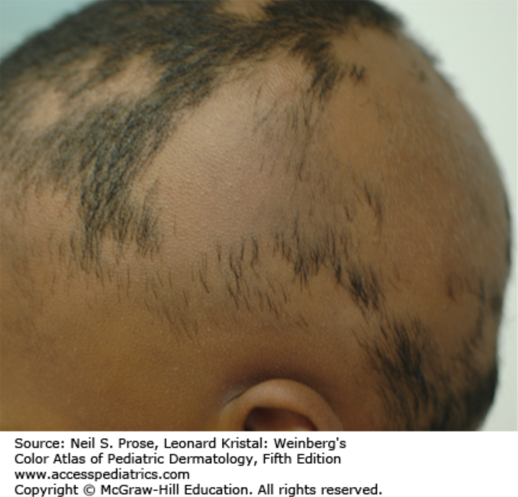He was not concerned until multiple additional patches were noted. His mother has not witnessed him pulling his hair.

What is the most likely diagnosis?
A. Alopecia areata.
B. Syphilis.
C. Telogen effluvium.
D. Tinea capitis.
E. Trichotillomania.
The correct answer is “A.” Alopecia areata is a common cause of nonscarring hair loss. It is characterized by the abrupt onset of patches of hair loss (focal alopecia areata; see Figure 33–12), complete loss of all scalp hair (alopecia totalis), or loss of all body hair (alopecia universalis). Alopecia tends to run a chronic and recurrent course, with the more severe variants being more resistant to treatment. Secondary syphilis is associated with a “moth-eaten” appearance of hair loss, coupled with scaling patches of the palms, trunk, or extremities. Telogen effluvium typically occurs following a physical or emotional stressor and involves the entire scalp. Patients note diffuse hair thinning, as opposed to discrete patches of hair loss. Tinea capitis is pruritic; examination demonstrates scale and broken hairs. A boggy, elevated lesion known as a kerion may develop. Trichotillomania is characterized by focal or widespread twisted and broken hairs, as a result of physical pulling and manipulation.
Sources:
Question & Explanation: Peterson AR, Wood KE. Pediatrics Examination and Board Review. New York, NY: McGraw-Hill Education; 2017.
Photo: Prose NS, Kristal L. Weinberg's Color Atlas of Pediatric Dermatology, 5e; 2017.






Create a Free MyAccess Profile
AccessMedicine Network is the place to keep up on new releases for the Access products, get short form didactic content, read up on practice impacting highlights, and watch video featuring authors of your favorite books in medicine. Create a MyAccess profile and follow our contributors to stay informed via email updates.